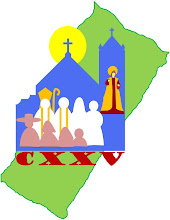Note: I'm still fixing this up. If you have some or better photos of our parish church, please send it to . The text here is from the General Instruction of the Roman Missal from the Vatican website.[288] For the celebration of the Eucharist, the people of God normally are gathered together in a church or, if there is no church or if it is too small, then in another respectable place that is nonetheless worthy of so great a mystery. Churches, therefore, and other places should be suitable for carrying out the sacred action and for ensuring the active participation of the faithful. Sacred buildings and requisites for divine worship should, moreover, be truly worthy and beautiful and be signs and symbols of heavenly realities.
The Sanctuary[295] The sanctuary is the place where the altar stands, where the word of God is proclaimed, and where the priest, the deacon, and the other ministers exercise their offices. It should suitably be marked off from the body of the church either by its being somewhat elevated or by a particular structure and ornamentation. It should, however, be large enough to allow the Eucharist to be celebrated properly and easily seen

 The Altar
The Altar[296] The altar on which the Sacrifice of the Cross is made present under sacramental signs is also the table of the Lord to which the People of God is called together to participate in the Mass, as well as the center of the thanksgiving that is accomplished through the Eucharist.
The Ambo[309] The dignity of the word of God requires that the church have a place that is suitable for the proclamation of the word and toward which the attention of the whole congregation of the faithful naturally turns during the Liturgy of the Word.
The Chair of the Priest Celebrant[310] The chair of the priest celebrant must signify his office of presiding over the gathering and of directing the prayer.
The Place of the Reservation of the Most Holy Eucharist
[314] In accordance with the structure of each church and legitimate local customs, the Most Blessed Sacrament should be reserved in a tabernacle in a part of the church that is truly noble, prominent, readily visible, beautifully decorated, and suitable for prayer.
 The Places for the Faithful
The Places for the Faithful[311] Places should be arranged with appropriate care for the faithful so that they are able to participate in the sacred celebrations visually and spiritually, in the proper manner. It is expedient for benches or seats usually to be provided for their use. The custom of reserving seats for private persons, however, is reprehensible.
Moreover, benches or chairs should be arranged, especially in newly built churches, in such a way that the people can easily take up the postures required for the different parts of the celebration and can easily come forward to receive Holy Communion.
 The Place for the Choir
The Place for the Choir[312] The choir should be positioned with respect to the design of each church so as to make clearly evident its character as a part of the gathered community of the faithful fulfilling a specific function. The location should also assist the choir to exercise its function more easily and conveniently allow each choir member full, sacramental participation in the Mass.
Saint Mary Magdalene[318] [I]mages of the Lord, the Blessed Virgin Mary, and the Saints, in accordance with the Church’s most ancient tradition, should be displayed for veneration by the faithful in sacred buildings.
 Baptismal Font
Baptismal Font









































 This day is also called the Exaltation of the Cross, Elevation of the Cross, Holy Cross Day, Holy Rood Day, or Roodmas. The liturgy of the Cross is a triumphant liturgy. When Moses lifted up the bronze serpent over the people, it was a foreshadowing of the salvation through Jesus when He was lifted up on the Cross. Our Mother Church sings of the triumph of the Cross, the instrument of our redemption. To follow Christ we must take up His cross, follow Him and become obedient until death, even if it means death on the cross. We identify with Christ on the Cross and become co-redeemers, sharing in His cross.
This day is also called the Exaltation of the Cross, Elevation of the Cross, Holy Cross Day, Holy Rood Day, or Roodmas. The liturgy of the Cross is a triumphant liturgy. When Moses lifted up the bronze serpent over the people, it was a foreshadowing of the salvation through Jesus when He was lifted up on the Cross. Our Mother Church sings of the triumph of the Cross, the instrument of our redemption. To follow Christ we must take up His cross, follow Him and become obedient until death, even if it means death on the cross. We identify with Christ on the Cross and become co-redeemers, sharing in His cross.







